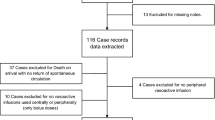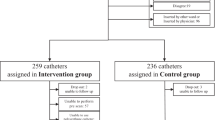Abstract
Objective:
To determine the efficacy of heparinized saline administered as intermittent flush on functional duration of the peripheral intravenous catheter (PIVC) in neonates.
Study Design:
Randomized, double-blind and placebo-controlled trial. Setting: Neonatal intensive care unit of a teaching hospital. Participants: Term and preterm neonates born at >32 weeks of gestation who required PIVC only for intermittent administration of antibiotics. Intervention: Eligible neonates were randomized to receive 1 ml of either heparinized saline (10 U ml−1) (n=60) or normal saline (n=60) every 12 h before and after intravenous antibiotics. Main outcome measure: Functional duration of first peripheral intravenous catheter.
Result:
A total of 120 neonates were randomized to two groups of 60 neonates each. The mean (s.d.) of age of babies in case and control group was 5.7 (2.5) days and 4.6 (3.1) days, respectively. The average weight of babies in both the groups was 2.1 kg. Mean functional duration of first catheter was more in heparinized saline group, mean (s.d.) of 71.68 h (27.3) as compared with 57.7 h (23.6) in normal saline group (P<0.005). The mean (95% confidence interval) difference in functional duration in the two groups was 13.9 h (4.7–23.15). Mean duration of patency for any catheter was also significantly more in heparinized saline group than control group.
Conclusion:
Heparinized saline flush increases the functional duration of peripheral intravenous catheter.
This is a preview of subscription content, access via your institution
Access options
Subscribe to this journal
Receive 12 print issues and online access
$259.00 per year
only $21.58 per issue
Buy this article
- Purchase on Springer Link
- Instant access to full article PDF
Prices may be subject to local taxes which are calculated during checkout



Similar content being viewed by others
References
Johnston CC, Stevens BJ . Experience in a neonatal intensive care unit affects pain response. Pediatrics 1996; 98: 925–930.
Dalal SS, Chawla D, Singh J, Agarwal RK, Deorari AK, Paul VK . Limb splinting for intravenous cannulae in neonates: a randomised controlled trial. Arch Dis Child Fetal Neonatal Ed 2009; 94: 394–396.
Shah P, Ng E, Sinha A . Heparin for prolonging peripheral intravenous catheter use in neonates. Cochrane Database Syst Rev 2005; 3: CD002774.
Mudge B, Forcier D, Slattery MJ . Patency of 24 gauge peripheral intermittent device: a comparison of heparin and saline flush solutions. Pediatr Nurs 1998; 24: 142–145, 149.
Lesko SM, Mitchell AA, Epstein MF, Louik C, Giacoia GP, Shapiro S . Heparin use as a risk factor for intraventricular hemorrhage in low-birth-weight infants. N Eng J Med 1986; 314: 1156–1160.
Ahmed I, Majeed A, Powell R . Heparin induced thrombocytopenia: diagnosis and management update. Postgrad Med J 2007; 83: 575–582.
Danek GD, Noris EM . Pediatric IV catheters: efficacy of saline flush. Pediatric Nursing 1992; 18: 111–113.
Taylor J, Shanon R, Kilbride H . Heparin lock intravenous line use in newborn infants: a controlled trial. Clinic Pediatr 1989; 28: 237–240.
Flint A, Davies M . The intravenous cannula for newborn infants requiring only intravenous medication: continuous infusion or intermittent flushing? J Infus Nurs 2008; 31: 346–349.
Pereza A, Feuza I, Brotschi B, Bernet V . Intermittent flushing improves cannula patency compared to continuous infusion for peripherally inserted venous catheters in newborns: results from a prospective observational study. J Perinat Med 2012; 40: 311–314.
Kotter RW . Heparin vs saline for intermittent intravenous device maintenance in neonates. Neonatal Netw 1996; 15: 43–47.
Paisley MK, Stamper M, Brown J, Brown N, Ganong LH . The use of heparin and normal saline flushes in neonatal intravenous catheters. Pediatr Nurs 1997; 23: 521–527.
Hanrahan KS, Kleiber C, Berends S . Saline for peripheral intravenous locks in neonates: evaluating change in practice. Neonatal Network 2000; 19: 19–24.
Arnts IJ, Heijnen JA, Wilbers HT, van der Wilt GJ, Groenewoud JM, Liem KD . Effectiveness of heparin solution versus normal saline in maintaining patency of intravenous locks in neonates: a double blind randomized controlled study. J Adv Nurs 2011; 67: 2677–2685.
Schultz AA, Drew D, Hewitt H . Comparison of normal saline and heparinized saline for patency of IV locks in neonates. Appl Nurs Res 2002; 15: 28–34.
Cook L, Bellini S, Cusson RM . Heparinized saline vs normal saline for maintenance of intravenous access in neonates: an evidence-based practice change. Adv Neonatal Care 2011; 11: 208–215.
Golberg M, Sankaran R, Givelichan L, Sankaran K . Maintaining patency of peripheral intermittent infusion devices with heparinized saline and saline. Neonatal Intensive Care 1999; 12: 18–22.
Heilskov J, Kleiber C, Johnson K, Miller J . A randomized trial of heparin and saline for maintaining intravenous locks in neonates. J Soc Pediatr Nurs 1998; 3: 111–116.
Bertolino G, Pitassi A, Tinelli C, Staniscia A, Guglielmana B, Scudeller L, Luigi Balduini C . Intermittent flushing with heparin versus saline for maintenance of peripheral intravenous catheters in a medical department: a pragmatic cluster-randomized controlled study. Worldviews Evid Based Nurs 2012; 9: 221–226.
Author information
Authors and Affiliations
Corresponding author
Additional information
This abstract was presented in annual meeting of Pediatrics Academic Society (PAS) held in BOSTON, USA(E-PAS2012:4524.320)
Rights and permissions
About this article
Cite this article
Upadhyay, A., Verma, K., Lal, P. et al. Heparin for prolonging peripheral intravenous catheter use in neonates: a randomized controlled trial. J Perinatol 35, 274–277 (2015). https://doi.org/10.1038/jp.2014.203
Received:
Revised:
Accepted:
Published:
Issue Date:
DOI: https://doi.org/10.1038/jp.2014.203
This article is cited by
-
Heparin versus normal saline for the care of peripheral intravenous catheters in pediatrics: a meta-analysis of randomized controlled trials
BMC Pediatrics (2024)
-
Continuous infusion versus intermittent flushing: maintaining peripheral intravenous access in newborn infants
Journal of Perinatology (2016)



